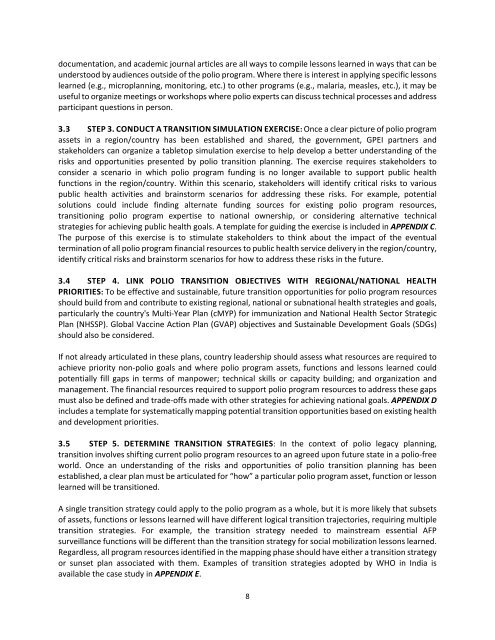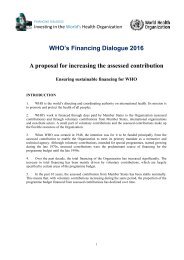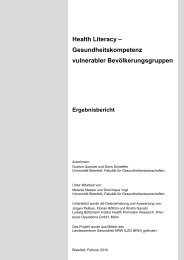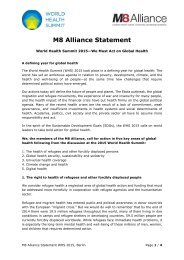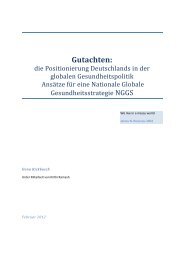POLIO PLANNING
TransitionGuidelinesForPolioLegacy
TransitionGuidelinesForPolioLegacy
You also want an ePaper? Increase the reach of your titles
YUMPU automatically turns print PDFs into web optimized ePapers that Google loves.
documentation, and academic journal articles are all ways to compile lessons learned in ways that can be<br />
understood by audiences outside of the polio program. Where there is interest in applying specific lessons<br />
learned (e.g., microplanning, monitoring, etc.) to other programs (e.g., malaria, measles, etc.), it may be<br />
useful to organize meetings or workshops where polio experts can discuss technical processes and address<br />
participant questions in person.<br />
3.3 STEP 3. CONDUCT A TRANSITION SIMULATION EXERCISE: Once a clear picture of polio program<br />
assets in a region/country has been established and shared, the government, GPEI partners and<br />
stakeholders can organize a tabletop simulation exercise to help develop a better understanding of the<br />
risks and opportunities presented by polio transition planning. The exercise requires stakeholders to<br />
consider a scenario in which polio program funding is no longer available to support public health<br />
functions in the region/country. Within this scenario, stakeholders will identify critical risks to various<br />
public health activities and brainstorm scenarios for addressing these risks. For example, potential<br />
solutions could include finding alternate funding sources for existing polio program resources,<br />
transitioning polio program expertise to national ownership, or considering alternative technical<br />
strategies for achieving public health goals. A template for guiding the exercise is included in APPENDIX C.<br />
The purpose of this exercise is to stimulate stakeholders to think about the impact of the eventual<br />
termination of all polio program financial resources to public health service delivery in the region/country,<br />
identify critical risks and brainstorm scenarios for how to address these risks in the future.<br />
3.4 STEP 4. LINK <strong>POLIO</strong> TRANSITION OBJECTIVES WITH REGIONAL/NATIONAL HEALTH<br />
PRIORITIES: To be effective and sustainable, future transition opportunities for polio program resources<br />
should build from and contribute to existing regional, national or subnational health strategies and goals,<br />
particularly the country's Multi-Year Plan (cMYP) for immunization and National Health Sector Strategic<br />
Plan (NHSSP). Global Vaccine Action Plan (GVAP) objectives and Sustainable Development Goals (SDGs)<br />
should also be considered.<br />
If not already articulated in these plans, country leadership should assess what resources are required to<br />
achieve priority non-polio goals and where polio program assets, functions and lessons learned could<br />
potentially fill gaps in terms of manpower; technical skills or capacity building; and organization and<br />
management. The financial resources required to support polio program resources to address these gaps<br />
must also be defined and trade-offs made with other strategies for achieving national goals. APPENDIX D<br />
includes a template for systematically mapping potential transition opportunities based on existing health<br />
and development priorities.<br />
3.5 STEP 5. DETERMINE TRANSITION STRATEGIES: In the context of polio legacy planning,<br />
transition involves shifting current polio program resources to an agreed upon future state in a polio-free<br />
world. Once an understanding of the risks and opportunities of polio transition planning has been<br />
established, a clear plan must be articulated for “how” a particular polio program asset, function or lesson<br />
learned will be transitioned.<br />
A single transition strategy could apply to the polio program as a whole, but it is more likely that subsets<br />
of assets, functions or lessons learned will have different logical transition trajectories, requiring multiple<br />
transition strategies. For example, the transition strategy needed to mainstream essential AFP<br />
surveillance functions will be different than the transition strategy for social mobilization lessons learned.<br />
Regardless, all program resources identified in the mapping phase should have either a transition strategy<br />
or sunset plan associated with them. Examples of transition strategies adopted by WHO in India is<br />
available the case study in APPENDIX E.<br />
8


